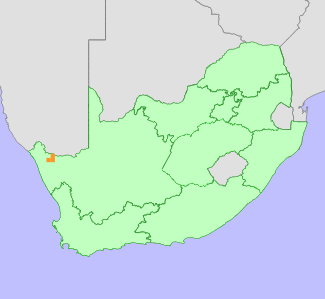|
Scientific Name | Conophytum devium G.D.Rowley subsp. devium |
Higher Classification | Dicotyledons |
Family | AIZOACEAE |
Synonyms | Ophthalmophyllum littlewoodii L.Bolus |
National Status |
Status and Criteria | Endangered A4d |
Assessment Date | 2021/11/22 |
Assessor(s) | A.J. Young, P.G. Desmet, I. Ebrahim, D. Guo, A. Harrower, L. Jabar, L. Knoetze, C. Rodgerson, P.C.V. Van Wyk & N.N. Mhlongo |
Justification | This succulent is endemic to the Northern Cape province of South Africa with an extent of occurrence (EOO) of 280 km² and area of occupancy (AOO) of 56 km². The population is experiencing initial levels of decline due to the illegal ornamental succulent plant trade, with collection likely to increase as there has been a dramatic increase in the number of species and volume of plants targeted since 2019. The continued threat of illegal collection is regarded as high for this particular taxon but the plants are amongst the smallest in the genus with their semi-subterranean habit rendering them highly cryptic. This combined with the scattered distribution across its range in a remote area may save to limit future population decline to 50-55%. Climate change is also highly likely to impact the population although there is uncertainty of the response given the expected resilience of this taxon. It therefore qualifies as Endangered under criterion A4. |
Distribution |
Endemism | South African endemic |
Provincial distribution | Northern Cape |
Range | This dwarf succulent is endemic to the Northern Cape province of South Africa. |
Habitat and Ecology |
Major system | Terrestrial |
Major habitats | Eenriet Plains Succulent Shrubland, Umdaus Mountains Succulent Shrubland, Eastern Gariep Rocky Desert |
Description | Plants are restricted to the Richtersveld bioregion of the Succulent Karoo biome. This succulent favours relatively flat areas of feldspar-quartzite where only a small part of the plant may be exposed under favourable conditions. This taxon has a generation length of 30 years. It is expected to be sensitive to the impacts of climate change as it does not disperse and while adapted to arid conditions, is dependent on limited seasonal rainfall. Species in the genus are sensitive to long periods of drought. Drought related mortality has been observed for other closely related taxa within the genus. |
Threats |
| This succulent is currently threatened by illegal collection for the international trade in ornamental succulents. This is likely to increase in future as there has been a dramatic increase in the number of species and volume of plants targeted since 2019.
There is no decline in habitat quality for this taxon as inferred by changes in vegetation cover determined from changes in Enhanced Vegetation Index (EVI) between 1984 and 2018 using Landsat data (Venter et al. 2020). Anthropogenic climate change is a long-term threat to this succulent. Climate models for the likely emission scenarios where emissions stay at present day levels (RCP 2.6) (Hausfather and Peters 2020) and worst case scenarios where emissions continue to increase during the 21st century (RCP 8.5) indicate that there will be a loss of suitable bioclimatic envelope of between 47% and 97% by 2080 for this taxon. However, as this taxon possesses certain morphological traits likely to afford resilience to xerophytic conditions it is expected to have a level of resilience to climate change and the expected population loss is reduced by 20% to 27%. Species in this genus have limited dispersal ability and migration to suitable habitats elsewhere is regarded as highly unlikely. |
Population |
It is one of the smallest in the genus and is also highly cryptic, having a semi-subterranean habit. There are no formal estimates of population size but is likely to consist of between 4,000 and 8,000 mature individuals. The population is in decline due to illegal collection to supply the international trade in ornamental succulents.
|
Population trend | Decreasing |
Assessment History |
Taxon assessed |
Status and Criteria |
Citation/Red List version | | Conophytum devium G.D.Rowley subsp. devium | Rare | 2015.1 | | Conophytum devium G.D.Rowley subsp. devium | Least Concern | Raimondo et al. (2009) | | Conophytum devium G.D.Rowley subsp. devium | Not Threatened | Hilton-Taylor (1996) | | Ophthalmophyllum littlewoodii L.Bolus | Uncertain | Hall et al. (1980) | |
Bibliography |
Hammer, S. 2002. Dumpling and his wife: New view of the genus Conophytum. EAE Creative Colour, Norwich.
Hammer, S.A. 1993. The genus Conophytum: A conograph. Succulent Plant Publications, Pretoria.
Hausfather, Z. and Peters, G.P. 2020. Emissions - the 'business as usual' story is misleading. Nature 577(618-620).
Opel, M.R. 2004. The rediscovery of Crassula alcicornis. Haseltonia 10:38-40.
|
Citation |
| Young, A.J., Desmet, P.G., Ebrahim, I., Guo, D., Harrower, A., Jabar, L., Knoetze, L., Rodgerson, C., Van Wyk, P.C.V. & Mhlongo, N.N. 2021. Conophytum devium G.D.Rowley subsp. devium. National Assessment: Red List of South African Plants version 2024.1. Accessed on 2025/11/07 |
 Comment on this assessment
Comment on this assessment


